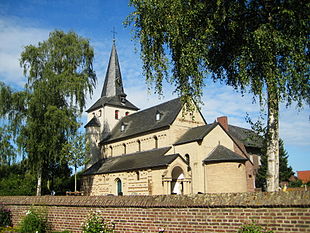St. Mary's Assumption (Ophoven)
The Church of St. Mary of the Assumption is the Roman Catholic branch church of the district Ophoven of the city of Wassenberg in the district of Heinsberg ( North Rhine-Westphalia ).
The church is registered under number 42 in the list of architectural monuments in Wassenberg .
History and architecture
Today's Sanctuary to Ophoven is the remnant of the Cistercian - Convention to Ophoven. It was originally the actual monastery church. Almost all of it dates from around 1200. In 1234 the monastery was moved from Ophoven to Dalheim . Goswin von Born gave his consent - but probably retrospectively, namely not until 1258. Probably there were two branches from 1234 to 1258. In 1571 the Cistercian church in Ophoven became the parish church of Ophoven. The patronage right (administrative sovereignty ) remained with the Dalheim monastery.
The church is a three-aisled, flat-roofed Romanesque pillar basilica made of tuff stone , consisting of a choir, apse in the east and the church tower in the west, also known as the west tower. The church is 19 m long and 10.5 m wide. There is a round arch portal in the west tower. The bell storey was built later and made of brick. The stair tower, also made of bricks, is on the south side. A four-leaf or quatrefoil window - which has Gothic style elements - was later installed in the apse . The sacristy on the north side dates from the 17th / 18th centuries. Century.
Around 1700 the pastor Abraham Zahren (1690–1725) - he came from Wassenberg and was buried in the church - had the church thoroughly renovated. He built the stair tower and the upper floor of the church tower. He also had the aisles and choir vaulted and a side altar acquired. In 1714 the church received a new roof and the bill was paid by Dalheim Monastery. The right of patronage still existed. In 1711 and 1735 three bells were placed in the newly erected part of the church tower. These weren't the first bells. A bell from 1613 broke and was re-cast in 1735 by the bell founder Christian Wilhelm Voigt from Dremmen. The second bell from 1720 was also cast by Voigt in 1735 with his name inscription. The third bell dates from 1474 and was re-cast in 1711. It bears the name of Pastor Zahren. In 1699 the Antwerp carved retable came to Ophoven, a gift from the Dalheim monastery. In 1721 a new paving was procured. Around 1750, the choir and the central nave were decorated with stucco. In 1735 the Rococo pulpit was built. The cross in the north right aisle dates from 1530. The most significant piece of the church is a miraculous image of Mary ("Maria amabilis"); it dates from around 1350.
The church patron sisters are the Blessed Mother and St. Agatha .
Furnishing
The center piece of the altarpiece comes from the Antwerp carving school and was completed in 1520. In 1699 the reredos came to Ophoven from Dalheim Monastery. From the first half of the 18th century with coming rococo provided headstones doors to altar boy sacristy, the Tabernakelaufbau with canopy and Volutenwerk and the rim of the altar shrine with rococo ornaments.
The individual groups of figures in the Antwerp reredos depict scenes from the life of Our Lady. The larger fields in the middle show the death of Mary, above the Assumption of Mary; on the left the Adoration of the Shepherds, on the right the Adoration of the Three Magi. The smaller fields depict the Annunciation, the Visitation, the circumcision of the baby Jesus, the representation in the temple, the flight into Egypt and the murder of children in Bethlehem. In the side grooves of the raised central compartment, smaller groups can be seen: the seven sacraments, the expulsion from paradise and the sacrifice of Abraham. Carved details show e.g. B. the contemporary fashion of the 16th century and cite habits or objects of daily life at that time. Some of the figures show a hand carved into the wood as the signature of the Antwerp carvers. The reredos is probably the work of four different carvers. The figures of one are characterized by oval heads and elongated bodies; the other carver preferred rounded heads and squat figures. The third carver was probably an apprentice; because gross inconsistencies can be demonstrated at various points.
The miraculous image of the Mother of God dates from around 1350. For many years the statue of the Virgin Mary and her child wore real, precious clothes. The miraculous effect of the Ophoven Mother of God was already famous at that time. Mighty princes and rulers moved with their entourage and men to the Rur to recommend their concerns to the “lovable mother”. The parish archive records a large number of healings and answers to prayer.
> Three steel bells hang in the tower, which were cast by the cast steel foundry "Bochumer Verein". They strike the notes g '- a' - h '.
Pilgrimage
To this day, in addition to the octaves of the Assumption of Mary and the Birth of Mary , 18 processions come to Ophoven from near and far to recommend themselves to the protection of the Mother of God, e.g. B. from Ratheim, Orsbeck, Wassenberg St. Georg and Oberstadt, Hilfarth, Effeld, Karken , Eschweiler, Heinsberg, Birgden, Oberbruch , Porselen-Horst, Kempen and Dalheim.
The church is usually only open in the small entrance hall. From there it is possible to look into the nave and the choir. Visits can be arranged at the rectory in Wassenberg.
Web links
Individual evidence
- ↑ J. Bürger: The Ratheim parish procession to Ophoven . In: District of Heinsberg (Hrsg.): Home calendar of the district of Heinsberg . 1996, ISSN 1615-7761 , p. 154 ff .
Coordinates: 51 ° 6 ′ 28.6 ″ N , 6 ° 6 ′ 5.9 ″ E


